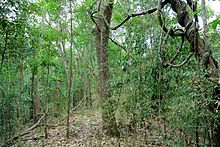Tropical and subtropical dry broadleaf forests

The tropical and subtropical dry broadleaf forest is a
Though less biologically diverse than rainforests, tropical dry forests are home to a wide variety of wildlife including monkeys, deer, large cats, parrots, various rodents, and ground dwelling birds. Mammalian biomass tends to be higher in dry forests than in rain forests, especially in Asian and African dry forests. Many of these species display extraordinary adaptations to the difficult climate.[1]
This biome is alternately known as the tropical and subtropical dry forest biome or the tropical and subtropical deciduous forest biome.
Geographical variation

Dry forests tend to exist in the drier areas north and south of the
Biodiversity patterns and requirements

Species tend to have wider ranges than
Effective conservation of dry broadleaf forests requires the preservation of large and continuous areas of forest. Large natural areas are required to maintain larger
Dry forests are highly sensitive to excessive burning and deforestation; overgrazing and exotic species can also quickly alter natural communities; restoration is possible but challenging, particularly if degradation has been intense and persistent.[1]
Ecoregions
Afrotropical realm
- Cape Verde Islands dry forests
- Madagascar dry deciduous forests
- Zambezian cryptosepalum dry forests
Australasian realm
- Lesser Sundas deciduous forests
- New Caledonia dry forests
- Sumba deciduous forests
- Timor and Wetar deciduous forests
Indomalayan realm
- Central Deccan Plateau dry deciduous forests
- Central Indochina dry forests
- Chota Nagpur Plateau
- East Deccan dry evergreen forests
- Irrawaddy dry forests
- Khathiar–Gir dry deciduous forests
- Narmada Valley dry deciduous forests
- Northern dry deciduous forests
- South Deccan Plateau dry deciduous forests
- Southeastern Indochina dry evergreen forests
- Southern Vietnam lowland dry forests
- Sri Lanka dry-zone dry evergreen forests
Nearctic realm
- Sonoran-Sinaloan transition subtropical dry forest
Neotropical realm
- Apure–Villavicencio dry forests
- Atlantic dry forests
- Bahamian dry forests
- Bajío dry forests
- Balsas dry forests
- Bolivian montane dry forests
- Cayman Islands dry forests
- Central American dry forests
- Chaco
- Chiapas Depression dry forests
- Chiquitano dry forests
- Cuban dry forests
- Ecuadorian dry forests
- Hispaniolan dry forests
- Jalisco dry forests
- Jamaican dry forests
- Lara–Falcón dry forests
- Leeward Islands dry forests
- Magdalena Valley dry forests
- Maracaibo dry forests
- Marañón dry forests
- Panamanian dry forests
- Patía Valley dry forests
- Puerto Rican dry forests
- Revillagigedo Islands
- Sierra de la Laguna dry forests
- Sinaloan dry forests
- Sinú Valley dry forests
- Southern Pacific dry forests
- Trinidad and Tobago dry forests
- Tumbes–Piura dry forests
- Veracruz dry forests
- Windward Islands dry forests
- Yucatán dry forests
Oceanian realm
- Fiji tropical dry forests
- Hawaiian tropical dry forests
- Marianas tropical dry forests
- Yap tropical dry forests
See also
References
- ^ a b c d e f g
 This article incorporates text available under the CC BY-SA 3.0 license. World Wide Fund for Nature. "Tropical and Subtropical Dry Broadleaf Forest Ecoregions". Archived from the original on 2012-04-25. Retrieved 2012-09-25.
This article incorporates text available under the CC BY-SA 3.0 license. World Wide Fund for Nature. "Tropical and Subtropical Dry Broadleaf Forest Ecoregions". Archived from the original on 2012-04-25. Retrieved 2012-09-25.
- ^ Gentry, A (1993). "Diversity and floristic composition of Neotropical dry forests". In Mooney, H; Bullock, S; Medina, E (eds.). Tropical deciduous forest ecosystems. Cambridge, UK: Cambridge University Press. pp. 146–194.
- "Deep-rooted Plants Have Much Greater Impact On Climate Than Experts Thought". Science Daily. 2006-01-13.
External links
 Media related to Tropical & Subtropical Dry Broadleaf Forests Biome at Wikimedia Commons
Media related to Tropical & Subtropical Dry Broadleaf Forests Biome at Wikimedia Commons- The Tropical Dry Forest of Costa Rica
